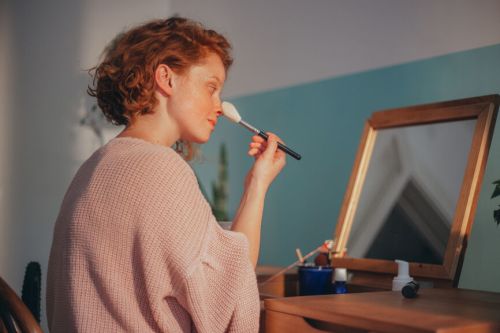What do lip gloss, leggings, and lube have in common? Besides the fact that they’re all fixings for a really good date night, you can now get each of these products laced with CBD—for softer lips, better workouts, and steamier sex, supposedly.
And that’s just the tip of the $5 billion iceberg that is the CBD consumer products market in 2019. Cannabidiol—a compound found in hemp plants that’s credited with various health benefits—is now making cameos in massages, facials, skin-care products, shampoos, and cosmetics including mascara. You can buy it pre-mixed in (not-quite legal) sparkling water, cold brew coffee, and cookies for humans and dogs alike. Even big brands like Ben & Jerry’s are developing new products with CBD on the ingredient list. This is all happening in a CBD landscape that’s still completely unregulated, and the products currently hitting the scene vary wildly in terms of efficacy and purity. So as increasingly, um, “creative” applications for CBD roll out faster than research backing its benefits can possibly keep up, it’s got many in the industry wondering one thing: Has CBD finally gone too far?
“Even though CBD is a real therapeutic agent, it’s also definitely a fad right now so we’re seeing it in a crazy array of products,” says Anna Symonds, director of education at craft cannabis and hemp farm East Fork Cultivars. “I’ve seen some gross-looking stuff—CBD burgers, CBD pizza, that kind of thing—that are clearly just attempts to get attention for the business, rather than offering any kind of real or responsible benefit.”
Boronia Fallshaw, founder of hemp wellness community and shop Mello, agrees that brands are rushing to capitalize on the hype swirling around CBD right now—perhaps understandably so, given that the market for such products is projected to increase by over 100 percent each year between now and 2023. “I do believe [many of] these products have been created with good intentions, but [some] are using the current lack of consumer education to their advantage,” she says.
For one thing, many products that claim to include CBD are actually formulated with hemp seed oil, rather than full-spectrum hemp extract from the leaves of the plant. “Hemp seed oil has nourishing omegas, but zero CBD or other cannabinoids,” Fallshaw says. Another area of confusion: Beauty brands often blend CBD with other potent ingredients, and it’s hard to know which ones are actually providing the solution customers are looking for. “Skin products touting the anti-aging benefits of hemp extract [may] also contain retinol or other collagen-pumping vitamins. And shampoo promising to help your hair grow [may] also contain argan or castor oil.” In these cases, she explains, you may be paying a premium for CBD, but actually experiencing the benefits of other, less expensive ingredients.
Similarly, Symonds points out that although CBD is believed to have anti-inflammatory and anti-bacterial properties—and may be beneficial for skin conditions like acne, psoriasis, and eczema—more research needs to be done before we know whether it’s actually beneficial in beauty products. “While it probably couldn’t hurt to have CBD in, say, shampoo or mascara, it’s debatable how much benefit it really offers for the price difference,” she says.
Fallshaw is also suspicious of CBD-infused food, drinks, and supplements. “While some fantastic brands have considered bioavailability—there are great hemp extract oils that have been formulated to be absorbed effectively by your bloodstream and not be destroyed by your GI tract—there are also others that have just jumped in,” she says. “If a drink contains 10 milligrams of CBD oil and on average 80 percent of all oil we digest is discarded through your GI tract, then is it worth it? What is 2 milligrams of CBD really going to do?”
Not every eyebrow-raising CBD product is bogus, of course—for instance, Fallshaw is a huge fan of CBD-infused suppositories, like the ones made to alleviate menstrual cramps, while Symonds personally vouches for the cannabis salves that she uses to soothe minor sports injuries (although users have reported mixed results). But both experts say that there are a few things to look for when vetting whether a product’s the real deal or a scam. “At minimum, look for full-spectrum products that provide test results from a third-party accredited lab, showing potency—how many milligrams of CBD and THC and the percentages in the product—as well as purity, free from any pesticide or solvent residues, bacteria or mold, and heavy metals,” says Symonds.
You should also be wary of products that don’t include a full list of ingredients, or edibles that contain excess sugar, preservatives, and artificial flavors or colorings. “There’s no sense in consuming ingredients that detract from health or promote inflammation when you’re taking something to gain anti-inflammatory and homeostatic benefits,” says Symonds. And to avoid tainted products—because the CBD market is not yet rigorously regulated by the FDA—seek out products that are USDA certified organic or Sun + Earth Certified, a new organic certification for cannabis products that also accounts for environmental and social responsibility.
Ultimately, it’s important that we as consumers look upon every new CBD product—especially the ones that elicit a WTF? at first glance—with discernment. “This can be exasperating, and I do worry that it undermines the legitimate therapeutic benefits of CBD in the public eye,” says Symonds. “But, ultimately, I think things will shake out, the garbage will drop away, and the quality, helpful products will remain.”
CBD does have some promising benefits on the health front—for instance, scientists think it may help with opioid addiction recovery, while early research shows it could also be linked to anxiety relief.
Sign Up for Our Daily Newsletter
Get all the latest in wellness, trends, food, fitness, beauty, and more delivered right to your inbox.
Got it, you've been added to our email list.











